|
While he was in high school, Alan Klapmeier told his friends that he wanted to design and build airplanes. Determined and tenacious, he never wavered in his commitment. In the summer of 1976, after graduating from high school, Alan went to Oshkosh to look at homebuilts. That fall he went to Ripon College in Wisconsin where he majored in Economics and minored in Physics. While there, he met Jeff Viken, a fellow student majoring in Aeronautical Engineering. It was a providential meeting.
Alan (left) and Dale Klapmeier, founders of Cirrus Aircraft/Cirrus Design.
In 1978, Alan went back to Oshkosh with his brother, Dale (three years younger), to learn more about home-building. They were both thrilled with what they saw.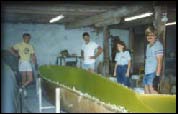 Two years later, they were on Wittman Field when Tom Hamilton arrived for the first time in his new Glasair I. Alan and Dale had to have one. Since they could barely afford a Big Mac between them, they went to their parents to see if they could borrow the money to order a kit. Thinking it would deter them, their parents asked the young men to write up a business plan explaining how a homebuilt aircraft project would further their education and careers. Though unexpected, the parents got their business plan after which Alan and Dale went out to the Glasair factory to place their order. The kit arrived in 1982 and the brothers got busy. Two years later, they were on Wittman Field when Tom Hamilton arrived for the first time in his new Glasair I. Alan and Dale had to have one. Since they could barely afford a Big Mac between them, they went to their parents to see if they could borrow the money to order a kit. Thinking it would deter them, their parents asked the young men to write up a business plan explaining how a homebuilt aircraft project would further their education and careers. Though unexpected, the parents got their business plan after which Alan and Dale went out to the Glasair factory to place their order. The kit arrived in 1982 and the brothers got busy.
Though they had dreamed and talked about designing their own airplane, a certified airplane, they began to shift their focus to homebuilts where they could enjoy the freedom the Experimental Amateur-Built environment offered to designers. They came to believe that the future of aviation was in homebuilding. By the time they had their Glasair flying, in the spring of 1984; Alan had
The  Kitmakers: Dale Klapmeier (left), High School buddy Scott Ellenberger, Pat Klapmeier and Alan Klapmeier. already begun developing sketches for what would become the world’s largest homebuilt: the first five place kit-plane. In addition to being large, Alan envisioned an aircraft that would be fast, stable, comfortable and quiet. Kitmakers: Dale Klapmeier (left), High School buddy Scott Ellenberger, Pat Klapmeier and Alan Klapmeier. already begun developing sketches for what would become the world’s largest homebuilt: the first five place kit-plane. In addition to being large, Alan envisioned an aircraft that would be fast, stable, comfortable and quiet.
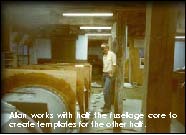 Anticipating their eventual plunge into kitmaking, Alan and Dale had created the Cirrus Aircraft Company in 1983. As they moved forward with their design, Alan called upon his friend from Ripon, Jeff Viken. Jeff was an aeronautical engineer, who eventually married another aeronautical engineer and the unpaid Cirrus staff grew to four volunteers. Anticipating their eventual plunge into kitmaking, Alan and Dale had created the Cirrus Aircraft Company in 1983. As they moved forward with their design, Alan called upon his friend from Ripon, Jeff Viken. Jeff was an aeronautical engineer, who eventually married another aeronautical engineer and the unpaid Cirrus staff grew to four volunteers.
Work on the VK-30 (VK standing for Viken-Klapmeier) became intense. They all pitched in with the designing and balanced that with hands-on labor in the shop. Jeff designed the airfoil, crunched the numbers on all of the component parts, while his wife designed the flap system and other components. They would finish designing a part or a system, build it, and then return to designing.
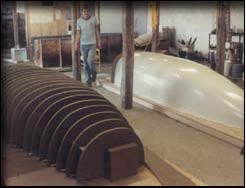 They bought a large quantity of foam, using it to hand carve half of the fuselage plug. Taking templates off the finished side, they carved out a symmetrical image on the other side. They invested months getting the fuselage core smooth and polished. When it came time to create tools that would provide fuselage halves the brothers took turns flying their Aeronca Champ up to Mora, Minnesota, where their uncle Jim was running a boat building business. Alan or Dale would then ask if they could “borrow” a few five gallon buckets of polyester resin to use on their tools. Since Uncle Jim bought resin by the tanker load, he waved them off with a smile. They bought a large quantity of foam, using it to hand carve half of the fuselage plug. Taking templates off the finished side, they carved out a symmetrical image on the other side. They invested months getting the fuselage core smooth and polished. When it came time to create tools that would provide fuselage halves the brothers took turns flying their Aeronca Champ up to Mora, Minnesota, where their uncle Jim was running a boat building business. Alan or Dale would then ask if they could “borrow” a few five gallon buckets of polyester resin to use on their tools. Since Uncle Jim bought resin by the tanker load, he waved them off with a smile.
Using the same style tools that were developed in their uncle’s boat building shops,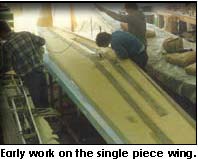 the brothers and the two engineers fabricated heavy duty boat tools for their aircraft. They laid up the first fuselage, popped it out of the molds and joined the two halves. Then they got inside and determined where to put the seats, instrument panel, windshield and windows, controls and airstair. Much of it was simply a matter of “it looks good here”. As the placement decisions were made, parts were designed and fabricated. the brothers and the two engineers fabricated heavy duty boat tools for their aircraft. They laid up the first fuselage, popped it out of the molds and joined the two halves. Then they got inside and determined where to put the seats, instrument panel, windshield and windows, controls and airstair. Much of it was simply a matter of “it looks good here”. As the placement decisions were made, parts were designed and fabricated.
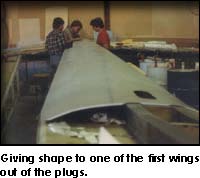 Work began on the 40’ single piece wing that was to be created with upper and lower surfaces bonded together. They cut out aluminum ribs and mounted them on a steel structure, then filled in the space between the ribs with chicken wire and plaster. Being a tapered wing, it presented a challenge, but that came nowhere near the frustrations they encountered day after day as they would sand the wing so it was straight and smooth, go home and the next morning they’d discover that the plaster had shrunk beneath the ribs. For weeks they worked at it, until the plaster finally stabilized and the perfect surface held long enough to develop a mold. They had put multiple coats of wax on the wing plug to assure a clean separation from the mold, but when they attempted to pry the core out of the mold, parts of the mold stuck to the core. More filling. More sanding. More time. Work began on the 40’ single piece wing that was to be created with upper and lower surfaces bonded together. They cut out aluminum ribs and mounted them on a steel structure, then filled in the space between the ribs with chicken wire and plaster. Being a tapered wing, it presented a challenge, but that came nowhere near the frustrations they encountered day after day as they would sand the wing so it was straight and smooth, go home and the next morning they’d discover that the plaster had shrunk beneath the ribs. For weeks they worked at it, until the plaster finally stabilized and the perfect surface held long enough to develop a mold. They had put multiple coats of wax on the wing plug to assure a clean separation from the mold, but when they attempted to pry the core out of the mold, parts of the mold stuck to the core. More filling. More sanding. More time.
In 1984, they renamed their company Cirrus Design and continued their work  schedule of 18/7, with some days shorter, some longer. They had no money and relied on their parents to support the program. To reduce costs, they took the control system out of a wrecked Piper. They also bought a Cherokee nose gear and welded the parts they needed on it to convert it to a retractable gear. They went to a junk yard and bought an 0-540 (290 hp) off a scrapped four engine Heron. Slowly, but surely, the first VK-30 took shape. They were sure they’d have it flying in time for Oshkosh ’87, but then they learned the hard way that 90% of the effort goes into the last 10% of the project. Their Oshkosh countdown finally forced them to dismantle the aircraft and truck it Oshkosh. The first flight would have to wait. schedule of 18/7, with some days shorter, some longer. They had no money and relied on their parents to support the program. To reduce costs, they took the control system out of a wrecked Piper. They also bought a Cherokee nose gear and welded the parts they needed on it to convert it to a retractable gear. They went to a junk yard and bought an 0-540 (290 hp) off a scrapped four engine Heron. Slowly, but surely, the first VK-30 took shape. They were sure they’d have it flying in time for Oshkosh ’87, but then they learned the hard way that 90% of the effort goes into the last 10% of the project. Their Oshkosh countdown finally forced them to dismantle the aircraft and truck it Oshkosh. The first flight would have to wait.
 So here you have a small, dedicated, hard working band of airplane builders in their 20’s and they’re off to Oshkosh with what they believe to be the
slickest, most beautiful, high performance (albeit untested) kitplane ever conceived. In their minds it was the future of aviation. They were coming to introduce their creation and to take orders for kits. They had hundreds of order forms printed up and actually joked about how they would manage crowd control and process all they orders they just knew would pile up during the week on the field. Ah, youth. They did get a few people to express some serious interest, but learned that an airplane that hadn’t flown yet wasn’t going to cut it with the EAA membership. They trucked their VK-30 back to their small shop in Baraboo with zero orders, disappointed but undaunted. So here you have a small, dedicated, hard working band of airplane builders in their 20’s and they’re off to Oshkosh with what they believe to be the
slickest, most beautiful, high performance (albeit untested) kitplane ever conceived. In their minds it was the future of aviation. They were coming to introduce their creation and to take orders for kits. They had hundreds of order forms printed up and actually joked about how they would manage crowd control and process all they orders they just knew would pile up during the week on the field. Ah, youth. They did get a few people to express some serious interest, but learned that an airplane that hadn’t flown yet wasn’t going to cut it with the EAA membership. They trucked their VK-30 back to their small shop in Baraboo with zero orders, disappointed but undaunted.
 They decided, while the aircraft was still in pieces, they ought to stress test the wing. They built up supports for it and began laying bags of sand on it. With a frightening sound that sent everyone ducking for cover, the outboard section of the wing failed, due to a sharp transition at the outboard end of the spar. Fiberglass and sand flew everywhere. They built a new, modified wing. It tested out fine. After countless times of saying “next week” or “next month” they were finally ready to fly by February 1988. They all wanted to make the first flight. Alan and Dale’s mother had other ideas, or let’s just say her protective instincts kicked in. They decided, while the aircraft was still in pieces, they ought to stress test the wing. They built up supports for it and began laying bags of sand on it. With a frightening sound that sent everyone ducking for cover, the outboard section of the wing failed, due to a sharp transition at the outboard end of the spar. Fiberglass and sand flew everywhere. They built a new, modified wing. It tested out fine. After countless times of saying “next week” or “next month” they were finally ready to fly by February 1988. They all wanted to make the first flight. Alan and Dale’s mother had other ideas, or let’s just say her protective instincts kicked in.
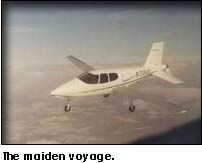 Jeff Viken knew a test pilot from NASA Langley, named Jim Patton. They invited him to Baraboo. He looked the aircraft over and was impressed, but told them that since he hadn’t been in on the project from the beginning, he didn’t want to jump in now. Three days later, after studying the aircraft and watching the team scramble to effect the changes he had recommended, Jim relented and offered to fly the aircraft. After a career as a test pilot, this was the first time that Jim got to fly a first flight of a new aircraft design. The team was impressed with his approach to getting ready and finally taking the active. After a few hops down the runway, Jim left the pattern, but soon turned back when the Klapmeir brothers, giving chase in their Glasair I, advised Jim that oil was pouring out through the prop shaft. They soon put that problem behind them, along with a number of others. Jeff Viken knew a test pilot from NASA Langley, named Jim Patton. They invited him to Baraboo. He looked the aircraft over and was impressed, but told them that since he hadn’t been in on the project from the beginning, he didn’t want to jump in now. Three days later, after studying the aircraft and watching the team scramble to effect the changes he had recommended, Jim relented and offered to fly the aircraft. After a career as a test pilot, this was the first time that Jim got to fly a first flight of a new aircraft design. The team was impressed with his approach to getting ready and finally taking the active. After a few hops down the runway, Jim left the pattern, but soon turned back when the Klapmeir brothers, giving chase in their Glasair I, advised Jim that oil was pouring out through the prop shaft. They soon put that problem behind them, along with a number of others.
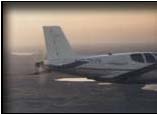 At Oshkosh ’88 they sold their first few kits. That fall, there were four people building VK-30s. Meanwhile, Alan and Dale were drawing up builder instructions as they worked on their second prototype. Between phone calls from the builders and their efforts to complete a second aircraft, they decided to try a different engine. They mounted a V-8 aluminum Chevy racing engine. There were cooling problems. They hoped to have it finished for Oshkosh ’90 and even expected to have a few of their customers’ aircraft there. Something happened to those optimistic dreams. At Oshkosh ’88 they sold their first few kits. That fall, there were four people building VK-30s. Meanwhile, Alan and Dale were drawing up builder instructions as they worked on their second prototype. Between phone calls from the builders and their efforts to complete a second aircraft, they decided to try a different engine. They mounted a V-8 aluminum Chevy racing engine. There were cooling problems. They hoped to have it finished for Oshkosh ’90 and even expected to have a few of their customers’ aircraft there. Something happened to those optimistic dreams.
After 15 hours of struggling with the auto engine radiator/cooling system, Alan took off on a routine test flight. Dale was chasing in the Glasair. Dale: “Alan, there’s 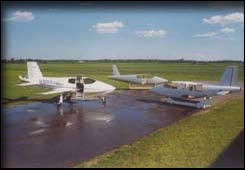 smoke coming out the back.” Alan: “Roger that.” Dale: “Alan, there’s fire coming out the back!” Alan cut the power, landed in a farmer’s field and stood there watching the second prototype go up in flames. When the fire died out they shoveled the aircraft remains into a truck. So at Oshkosh ’90, they had their first prototype again and there were no customers’ airplanes. smoke coming out the back.” Alan: “Roger that.” Dale: “Alan, there’s fire coming out the back!” Alan cut the power, landed in a farmer’s field and stood there watching the second prototype go up in flames. When the fire died out they shoveled the aircraft remains into a truck. So at Oshkosh ’90, they had their first prototype again and there were no customers’ airplanes.
The third prototype had a Continental turbo 550. It was the right engine. They got great performance and long range. They brought it to Oshkosh ’91 and that airplane, N33VK, is now in the EAA Museum. 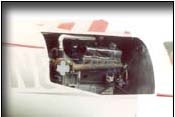
By the end of the ’91 Convention, they began to question their goals. They started thinking about their lifelong dream of getting into the world of certificated aircraft and Alan began making sketches for the ST-50, a four-seat jet. Dale wanted something simpler and began fiddling with a concept that was to evolve into the SR-20. But that’s a story for another time.
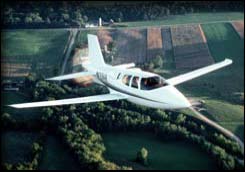 In the end, the Brothers Klapmeir shipped out 40 kits and created another four for factory prototypes. Ten customer aircraft flew. Eventually, when the Cirrus SR-20 was well along, they tried to buy back all the kits. They got 3/4ths of the people to sell their kits. The others are still out there…under construction. In the end, the Brothers Klapmeir shipped out 40 kits and created another four for factory prototypes. Ten customer aircraft flew. Eventually, when the Cirrus SR-20 was well along, they tried to buy back all the kits. They got 3/4ths of the people to sell their kits. The others are still out there…under construction.
Dale looked back at it all: “Alan was the inspiration, the driving force. In the end, however, we failed as kitmakers. It didn’t catch on as we’d hoped it would and finally we realized that the only way to go was Part 23. We had learned a lot, though, and that knowledge served us well.”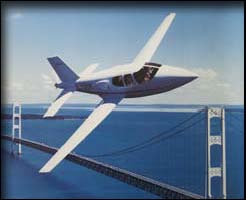
To date, the Klapmeir brothers and Lance Neibauer are the only two kit-makers who were able to successfully transition into the design and production of certificated aircraft. In both cases the EAA provided them with a great training ground. |


 Two years later, they were on Wittman Field when Tom Hamilton arrived for the first time in his new Glasair I. Alan and Dale had to have one. Since they could barely afford a Big Mac between them, they went to their parents to see if they could borrow the money to order a kit. Thinking it would deter them, their parents asked the young men to write up a business plan explaining how a homebuilt aircraft project would further their education and careers. Though unexpected, the parents got their business plan after which Alan and Dale went out to the Glasair factory to place their order. The kit arrived in 1982 and the brothers got busy.
Two years later, they were on Wittman Field when Tom Hamilton arrived for the first time in his new Glasair I. Alan and Dale had to have one. Since they could barely afford a Big Mac between them, they went to their parents to see if they could borrow the money to order a kit. Thinking it would deter them, their parents asked the young men to write up a business plan explaining how a homebuilt aircraft project would further their education and careers. Though unexpected, the parents got their business plan after which Alan and Dale went out to the Glasair factory to place their order. The kit arrived in 1982 and the brothers got busy.
 Kitmakers: Dale Klapmeier (left), High School buddy Scott Ellenberger, Pat Klapmeier and Alan Klapmeier. already begun developing sketches for what would become the world’s largest homebuilt: the first five place kit-plane. In addition to being large, Alan envisioned an aircraft that would be fast, stable, comfortable and quiet.
Kitmakers: Dale Klapmeier (left), High School buddy Scott Ellenberger, Pat Klapmeier and Alan Klapmeier. already begun developing sketches for what would become the world’s largest homebuilt: the first five place kit-plane. In addition to being large, Alan envisioned an aircraft that would be fast, stable, comfortable and quiet.
 Anticipating their eventual plunge into kitmaking, Alan and Dale had created the Cirrus Aircraft Company in 1983. As they moved forward with their design, Alan called upon his friend from Ripon, Jeff Viken. Jeff was an aeronautical engineer, who eventually married another aeronautical engineer and the unpaid Cirrus staff grew to four volunteers.
Anticipating their eventual plunge into kitmaking, Alan and Dale had created the Cirrus Aircraft Company in 1983. As they moved forward with their design, Alan called upon his friend from Ripon, Jeff Viken. Jeff was an aeronautical engineer, who eventually married another aeronautical engineer and the unpaid Cirrus staff grew to four volunteers.
 They bought a large quantity of foam, using it to hand carve half of the fuselage plug. Taking templates off the finished side, they carved out a symmetrical image on the other side. They invested months getting the fuselage core smooth and polished. When it came time to create tools that would provide fuselage halves the brothers took turns flying their Aeronca Champ up to Mora, Minnesota, where their uncle Jim was running a boat building business. Alan or Dale would then ask if they could “borrow” a few five gallon buckets of polyester resin to use on their tools. Since Uncle Jim bought resin by the tanker load, he waved them off with a smile.
They bought a large quantity of foam, using it to hand carve half of the fuselage plug. Taking templates off the finished side, they carved out a symmetrical image on the other side. They invested months getting the fuselage core smooth and polished. When it came time to create tools that would provide fuselage halves the brothers took turns flying their Aeronca Champ up to Mora, Minnesota, where their uncle Jim was running a boat building business. Alan or Dale would then ask if they could “borrow” a few five gallon buckets of polyester resin to use on their tools. Since Uncle Jim bought resin by the tanker load, he waved them off with a smile.
 the brothers and the two engineers fabricated heavy duty boat tools for their aircraft. They laid up the first fuselage, popped it out of the molds and joined the two halves. Then they got inside and determined where to put the seats, instrument panel, windshield and windows, controls and airstair. Much of it was simply a matter of “it looks good here”. As the placement decisions were made, parts were designed and fabricated.
the brothers and the two engineers fabricated heavy duty boat tools for their aircraft. They laid up the first fuselage, popped it out of the molds and joined the two halves. Then they got inside and determined where to put the seats, instrument panel, windshield and windows, controls and airstair. Much of it was simply a matter of “it looks good here”. As the placement decisions were made, parts were designed and fabricated.
 Work began on the 40’ single piece wing that was to be created with upper and lower surfaces bonded together. They cut out aluminum ribs and mounted them on a steel structure, then filled in the space between the ribs with chicken wire and plaster. Being a tapered wing, it presented a challenge, but that came nowhere near the frustrations they encountered day after day as they would sand the wing so it was straight and smooth, go home and the next morning they’d discover that the plaster had shrunk beneath the ribs. For weeks they worked at it, until the plaster finally stabilized and the perfect surface held long enough to develop a mold. They had put multiple coats of wax on the wing plug to assure a clean separation from the mold, but when they attempted to pry the core out of the mold, parts of the mold stuck to the core. More filling. More sanding. More time.
Work began on the 40’ single piece wing that was to be created with upper and lower surfaces bonded together. They cut out aluminum ribs and mounted them on a steel structure, then filled in the space between the ribs with chicken wire and plaster. Being a tapered wing, it presented a challenge, but that came nowhere near the frustrations they encountered day after day as they would sand the wing so it was straight and smooth, go home and the next morning they’d discover that the plaster had shrunk beneath the ribs. For weeks they worked at it, until the plaster finally stabilized and the perfect surface held long enough to develop a mold. They had put multiple coats of wax on the wing plug to assure a clean separation from the mold, but when they attempted to pry the core out of the mold, parts of the mold stuck to the core. More filling. More sanding. More time.
 schedule of 18/7, with some days shorter, some longer. They had no money and relied on their parents to support the program. To reduce costs, they took the control system out of a wrecked Piper. They also bought a Cherokee nose gear and welded the parts they needed on it to convert it to a retractable gear. They went to a junk yard and bought an 0-540 (290 hp) off a scrapped four engine Heron. Slowly, but surely, the first VK-30 took shape. They were sure they’d have it flying in time for Oshkosh ’87, but then they learned the hard way that 90% of the effort goes into the last 10% of the project. Their Oshkosh countdown finally forced them to dismantle the aircraft and truck it Oshkosh. The first flight would have to wait.
schedule of 18/7, with some days shorter, some longer. They had no money and relied on their parents to support the program. To reduce costs, they took the control system out of a wrecked Piper. They also bought a Cherokee nose gear and welded the parts they needed on it to convert it to a retractable gear. They went to a junk yard and bought an 0-540 (290 hp) off a scrapped four engine Heron. Slowly, but surely, the first VK-30 took shape. They were sure they’d have it flying in time for Oshkosh ’87, but then they learned the hard way that 90% of the effort goes into the last 10% of the project. Their Oshkosh countdown finally forced them to dismantle the aircraft and truck it Oshkosh. The first flight would have to wait.
 So here you have a small, dedicated, hard working band of airplane builders in their 20’s and they’re off to Oshkosh with what they believe to be the
slickest, most beautiful, high performance (albeit untested) kitplane ever conceived. In their minds it was the future of aviation. They were coming to introduce their creation and to take orders for kits. They had hundreds of order forms printed up and actually joked about how they would manage crowd control and process all they orders they just knew would pile up during the week on the field. Ah, youth. They did get a few people to express some serious interest, but learned that an airplane that hadn’t flown yet wasn’t going to cut it with the EAA membership. They trucked their VK-30 back to their small shop in Baraboo with zero orders, disappointed but undaunted.
So here you have a small, dedicated, hard working band of airplane builders in their 20’s and they’re off to Oshkosh with what they believe to be the
slickest, most beautiful, high performance (albeit untested) kitplane ever conceived. In their minds it was the future of aviation. They were coming to introduce their creation and to take orders for kits. They had hundreds of order forms printed up and actually joked about how they would manage crowd control and process all they orders they just knew would pile up during the week on the field. Ah, youth. They did get a few people to express some serious interest, but learned that an airplane that hadn’t flown yet wasn’t going to cut it with the EAA membership. They trucked their VK-30 back to their small shop in Baraboo with zero orders, disappointed but undaunted.
 They decided, while the aircraft was still in pieces, they ought to stress test the wing. They built up supports for it and began laying bags of sand on it. With a frightening sound that sent everyone ducking for cover, the outboard section of the wing failed, due to a sharp transition at the outboard end of the spar. Fiberglass and sand flew everywhere. They built a new, modified wing. It tested out fine. After countless times of saying “next week” or “next month” they were finally ready to fly by February 1988. They all wanted to make the first flight. Alan and Dale’s mother had other ideas, or let’s just say her protective instincts kicked in.
They decided, while the aircraft was still in pieces, they ought to stress test the wing. They built up supports for it and began laying bags of sand on it. With a frightening sound that sent everyone ducking for cover, the outboard section of the wing failed, due to a sharp transition at the outboard end of the spar. Fiberglass and sand flew everywhere. They built a new, modified wing. It tested out fine. After countless times of saying “next week” or “next month” they were finally ready to fly by February 1988. They all wanted to make the first flight. Alan and Dale’s mother had other ideas, or let’s just say her protective instincts kicked in.
 Jeff Viken knew a test pilot from NASA Langley, named Jim Patton. They invited him to Baraboo. He looked the aircraft over and was impressed, but told them that since he hadn’t been in on the project from the beginning, he didn’t want to jump in now. Three days later, after studying the aircraft and watching the team scramble to effect the changes he had recommended, Jim relented and offered to fly the aircraft. After a career as a test pilot, this was the first time that Jim got to fly a first flight of a new aircraft design. The team was impressed with his approach to getting ready and finally taking the active. After a few hops down the runway, Jim left the pattern, but soon turned back when the Klapmeir brothers, giving chase in their Glasair I, advised Jim that oil was pouring out through the prop shaft. They soon put that problem behind them, along with a number of others.
Jeff Viken knew a test pilot from NASA Langley, named Jim Patton. They invited him to Baraboo. He looked the aircraft over and was impressed, but told them that since he hadn’t been in on the project from the beginning, he didn’t want to jump in now. Three days later, after studying the aircraft and watching the team scramble to effect the changes he had recommended, Jim relented and offered to fly the aircraft. After a career as a test pilot, this was the first time that Jim got to fly a first flight of a new aircraft design. The team was impressed with his approach to getting ready and finally taking the active. After a few hops down the runway, Jim left the pattern, but soon turned back when the Klapmeir brothers, giving chase in their Glasair I, advised Jim that oil was pouring out through the prop shaft. They soon put that problem behind them, along with a number of others.
 At Oshkosh ’88 they sold their first few kits. That fall, there were four people building VK-30s. Meanwhile, Alan and Dale were drawing up builder instructions as they worked on their second prototype. Between phone calls from the builders and their efforts to complete a second aircraft, they decided to try a different engine. They mounted a V-8 aluminum Chevy racing engine. There were cooling problems. They hoped to have it finished for Oshkosh ’90 and even expected to have a few of their customers’ aircraft there. Something happened to those optimistic dreams.
At Oshkosh ’88 they sold their first few kits. That fall, there were four people building VK-30s. Meanwhile, Alan and Dale were drawing up builder instructions as they worked on their second prototype. Between phone calls from the builders and their efforts to complete a second aircraft, they decided to try a different engine. They mounted a V-8 aluminum Chevy racing engine. There were cooling problems. They hoped to have it finished for Oshkosh ’90 and even expected to have a few of their customers’ aircraft there. Something happened to those optimistic dreams.
 smoke coming out the back.” Alan: “Roger that.” Dale: “Alan, there’s fire coming out the back!” Alan cut the power, landed in a farmer’s field and stood there watching the second prototype go up in flames. When the fire died out they shoveled the aircraft remains into a truck. So at Oshkosh ’90, they had their first prototype again and there were no customers’ airplanes.
smoke coming out the back.” Alan: “Roger that.” Dale: “Alan, there’s fire coming out the back!” Alan cut the power, landed in a farmer’s field and stood there watching the second prototype go up in flames. When the fire died out they shoveled the aircraft remains into a truck. So at Oshkosh ’90, they had their first prototype again and there were no customers’ airplanes.

 In the end, the Brothers Klapmeir shipped out 40 kits and created another four for factory prototypes. Ten customer aircraft flew. Eventually, when the Cirrus SR-20 was well along, they tried to buy back all the kits. They got 3/4ths of the people to sell their kits. The others are still out there…under construction.
In the end, the Brothers Klapmeir shipped out 40 kits and created another four for factory prototypes. Ten customer aircraft flew. Eventually, when the Cirrus SR-20 was well along, they tried to buy back all the kits. They got 3/4ths of the people to sell their kits. The others are still out there…under construction.
